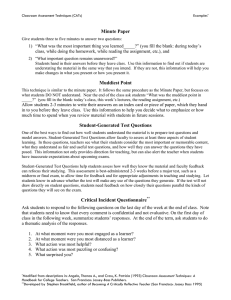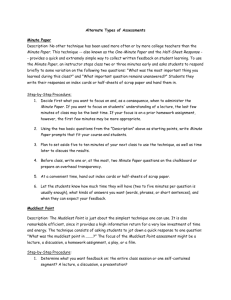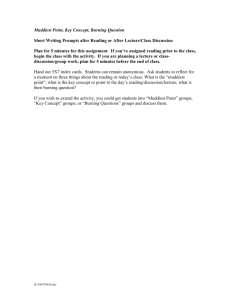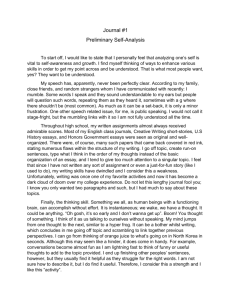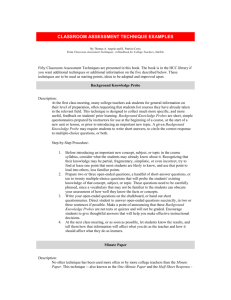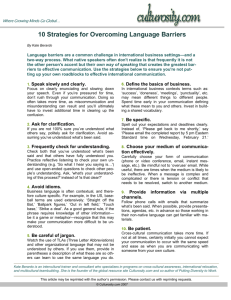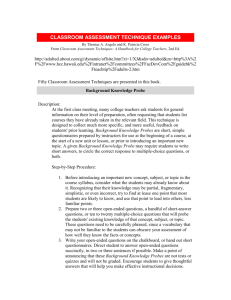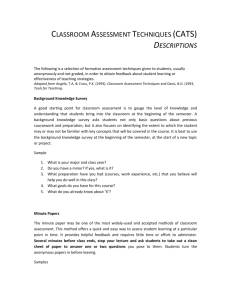Quick Assessments
advertisement
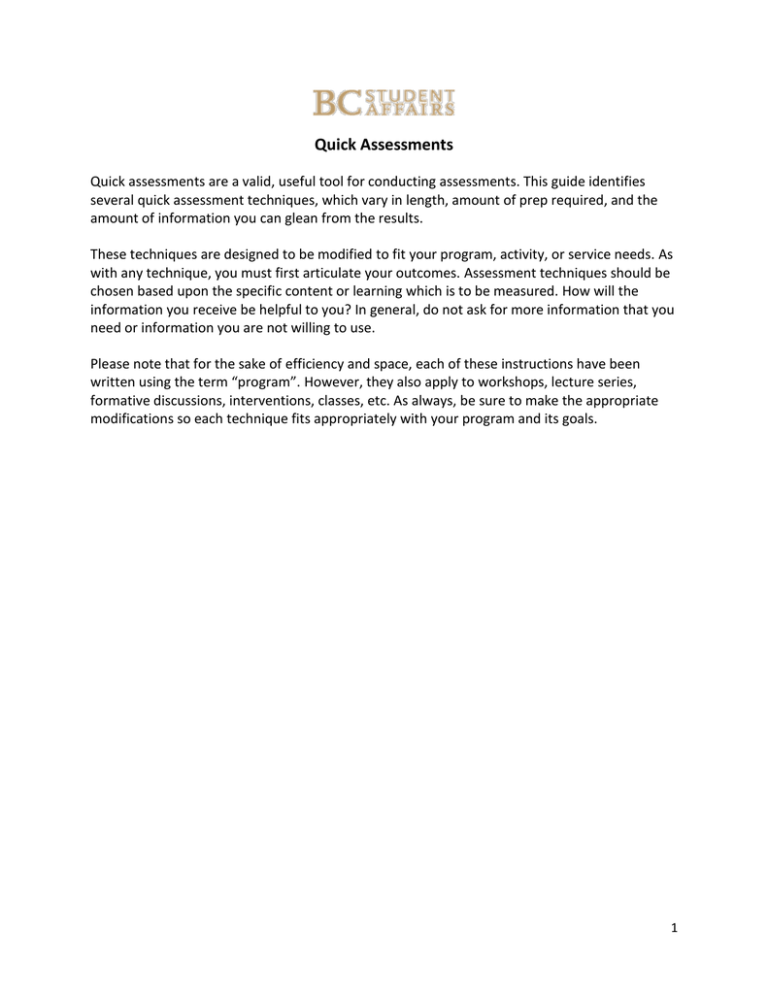
Quick Assessments Quick assessments are a valid, useful tool for conducting assessments. This guide identifies several quick assessment techniques, which vary in length, amount of prep required, and the amount of information you can glean from the results. These techniques are designed to be modified to fit your program, activity, or service needs. As with any technique, you must first articulate your outcomes. Assessment techniques should be chosen based upon the specific content or learning which is to be measured. How will the information you receive be helpful to you? In general, do not ask for more information that you need or information you are not willing to use. Please note that for the sake of efficiency and space, each of these instructions have been written using the term “program”. However, they also apply to workshops, lecture series, formative discussions, interventions, classes, etc. As always, be sure to make the appropriate modifications so each technique fits appropriately with your program and its goals. 1 Quick Assessment Techniques (by skill area assessed) Prior Knowledge, Recall and Understanding - Background Probe Misconception-Preconception Check One-minute Paper Muddiest Point Synthesis and Creative Thinking - One-Sentence Summary Problem Solving - Problem/Issue Recognition What’s the Principle? Documented Problem Solutions Application and Performance - Application Cards Directed Paraphrasing Student-Generated Test Questions Student Awareness of their Attitudes and Values - Secret Polling Everyday Ethical Dilemmas Learner Reactions to Teaching - Chain notes 2 The Techniques (in alphabetical order) Application cards Purpose: To verify that students understood that material and can apply it to a real-life situation. To do: After teaching about an important theory, principle, or procedure, ask students to write down at least one real-world application for what they have just learned to determine how well they can transfer their learning. Quickly read once through the applications and categorize them according to their quality. Considering picking out a broad range of examples and present them to the group to encourage peer-to-peer learning. Background Probe Purpose: This technique is designed to collect specific and useful feedback on students' prior learning on a topic. Can also be used to get a better understanding of why students are participating in a particular program. To do: In order to get a general idea of where students are coming from, have them list classes they have taken on a specific topic, trainings they have been to, and/or experiences they have had doing X, Y or Z. This is an effective way of quickly getting a pulse on where people are in their experiences so that you can tailor material appropriately. Chain Notes Purpose: To get on the spot feedback while program is progressing. Useful in large groups when you want to get a quick read on what people are thinking in the middle of the program. To do: At some point after the program has started, pass around an envelope on which you (administrator/staff member) have written one question about the program. The students have all been given index cards beforehand. When the envelope reaches a student, he or she spends less than a minute writing a response to the question, then drops the card in the envelope and passes it on. This assessment technique results in a rich, composite record of each individual student’s reactions to the program in action. In this way, Chain Notes allow staff/administrators a view of their program through all their students’ eyes. Directed paraphrasing Purpose: To ensure students understood a concept, process, idea, etc. To do: Ask students to write a layman’s "translation" of something they have just learned -geared to a specified individual or audience -- to assess their ability to comprehend and transfer concepts. Categorize student responses according to characteristics you feel are important. Analyze the responses both within and across categories, noting ways you could address student needs. 3 Documented Problem Solutions Purpose: This is the assessment version of “show your work”. It is a helpful tool that assists administrators to understand what the student was thinking and what steps he or she took to solve a problem. This is also useful in helping students clarify their thinking and become more deliberate in their problem-solving. To do: This technique asks students to keep track of the steps involved in solving particular types of problems. Staff can gain an awareness of the steps utilized by the students in solving problems. Develop clear-cut instructions for the class and recognize that the students will need more time for this task than was required by yourself or your colleagues asked to evaluate your assignment. Prepare the students for this activity and assure them that this is not a graded exercise. Emphasize that you are as interested in how they approach a problem as in obtaining a correct answer and that this activity will help them (and you) analyze their problem-solving skills. Misconception – Preconception Check Purpose: This technique can be used at the beginning of a program to assess students misconceptions or preconceptions on a specific topic. It can also be used at the end of a program to see if misconceptions are clearing up or growing, whether preconceptions are being reshaped and to see if students are improving in their abilities to assess relevant information and filter out inaccuracies. To do: Ask students a question (or a few questions) before and after a particular program. This can be done in popcorn style, a formal (ungraded) quiz, group work, etc. Muddiest Point Purpose: To understand what students found most confusing. This exercise asks students to reflect upon the program, to decide what they understood and what was unclear and to selfassess their learning and identify what worked and did not work. To do: At end of program, ask students to identify and/or describe the muddiest point of a workshop (or segment of the workshop) you are interested in. Pass out slips of paper or index cards for students to write on. Collect the responses as or before students leave. Respond to the students' feedback during the next class meeting or as soon as possible afterward. You can specifically ask students "What point remains least clear to you?" or "What important question do you have that remains unanswered?" One-minute paper Purpose: To get information from students at the conclusion of a program. Depending on the question(s) you ask, this requires students to recall and understand the material, evaluate themselves on what they recall and self-assess their learning and understanding. 4 To do: Towards the end of a workshop/program/class, ask students to answer on a half-sheet of paper a quick question that will help you gauge how much and what the students learned. Examples include: "What is the most important point you learned today?", “What was the most beneficial aspect of the session today?”, “What was most hopeful in helping you learn about X?” or “What are you most and/or least satisfied with?” One-sentence summary Purpose: To see the main ideas that students took from the program. To do: Ask students to summarize the main ideas they've taken away from a lecture, discussion, or assigned reading. Students summarize knowledge of a topic by constructing a single sentence that answers the questions "Who does what to whom, when, where, how, and why?" The purpose is to require students to select only the defining features of an idea. Evaluate the quality of each summary quickly and holistically. Note whether students have identified the essential concepts of the class topic and their interrelationships. Share your observations with your students. Pre-Post Test Purpose: Assesses student learning before program and after to demonstrate progression. To do: Have students complete a mini test or do a particular exercise before a program begins. Have students repeat the task at the end of the program. Analyze the pre-test and post-test to better understand the growth in learning the students experienced as a result of the program. Problem/Issue Recognition Purpose: Assesses whether students are able to identify the problem in a situation. To do: Present an example common problem (or several examples to different problems) to students and ask them to identify the basic type of problem represented by each sample. They can do so by a show of hands, group work and choosing the best answer, writing them down, etc. This is particularly helpful when teaching about helping skills. Secret Polling Purpose: Use when you want to poll students who seem hesitant to respond to questions publicly or when you want responses that aren’t swayed by the influence of other students To do: Ask a multiple-choice question and assign a number (1 – 5) to each response. Have students hold up the number of fingers that correlates with their response to their chest so that only the presenter can see their response. Sample questions include “If X happened, what would office procedures require that you do? Put one finger up if you think Y, 2 fingers if you think Z.” Or more serious topics like “how many of you have experienced gender discrimination within the past year? 1 if you have, 2 if you have not” 5 Self-Confidence Worksheet Purpose: Useful to help gauge a student’s comfort level on a particular topic. To do: This can be administered either at the beginning of a particular session or throughout the session(s) to measure progress. In advance, design a survey where students can rate how comfortable they feel in any particular areas (for example, public speaking skills, challenging a friend on his/her inappropriate use of alcohol, booking a room through EBMS, etc). Students can then rate their confidence on a scale of “none, low, medium, or high”. You can then review the self-evaluations and tailor strategies accordingly. Student-Generated Handbook Purpose: To see if students understood a concept well enough to teach it to others. To do: Have students write a handbook or manual, of any length – 3 steps to 30 pages regarding a certain task that is geared towards other students who would be learning the material. This may be particularly helpful when training student workers and having them write down the instructions for “welcoming individuals who enter the office” or “responding to front desk inquiries”. Review the handbooks/guides for concepts that the students grasped or may have missed. Give group feedback to students and review any topics or areas which proved to be particularly challenging. Student-Generated Test Questions Purpose: To see if students understood material enough to be able to work with it, apply it, etc. To do: Allow students to write test questions and model answers for specified topics, in a format consistent with a typical course’s exams. This will give students the opportunity to evaluate the workshop, activity, or program topics, reflect on what they understand, and what are good test items. Make a rough tally of the questions your students propose and the topics that they cover. Evaluate the questions and use the good ones as prompts for discussion. What’s the Principle? Purpose: Assesses whether students can identify the principle(s) one would use to solve a problem. To do: This technique follows the Problem Recognition technique in that once a type of problem is correctly identified, students must identify what principles or techniques or standards are involved in the class must be applied to solve or resolve the problem. 6

